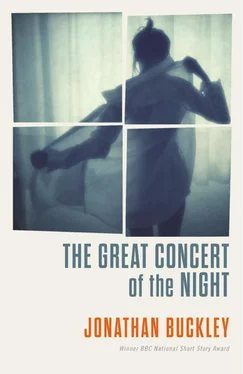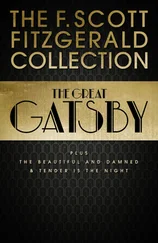Jonathan Buckley - The Great Concert of the Night
Здесь есть возможность читать онлайн «Jonathan Buckley - The Great Concert of the Night» весь текст электронной книги совершенно бесплатно (целиком полную версию без сокращений). В некоторых случаях можно слушать аудио, скачать через торрент в формате fb2 и присутствует краткое содержание. Город: London, Год выпуска: 2018, ISBN: 2018, Издательство: Sort Of Books, Жанр: Современная проза, на английском языке. Описание произведения, (предисловие) а так же отзывы посетителей доступны на портале библиотеки ЛибКат.
- Название:The Great Concert of the Night
- Автор:
- Издательство:Sort Of Books
- Жанр:
- Год:2018
- Город:London
- ISBN:978-1-908745-78-1
- Рейтинг книги:4 / 5. Голосов: 1
-
Избранное:Добавить в избранное
- Отзывы:
-
Ваша оценка:
- 80
- 1
- 2
- 3
- 4
- 5
The Great Concert of the Night: краткое содержание, описание и аннотация
Предлагаем к чтению аннотацию, описание, краткое содержание или предисловие (зависит от того, что написал сам автор книги «The Great Concert of the Night»). Если вы не нашли необходимую информацию о книге — напишите в комментариях, мы постараемся отыскать её.
The Great Concert of the Night — читать онлайн бесплатно полную книгу (весь текст) целиком
Ниже представлен текст книги, разбитый по страницам. Система сохранения места последней прочитанной страницы, позволяет с удобством читать онлайн бесплатно книгу «The Great Concert of the Night», без необходимости каждый раз заново искать на чём Вы остановились. Поставьте закладку, и сможете в любой момент перейти на страницу, на которой закончили чтение.
Интервал:
Закладка:
Her body was brought to San Crisogono in 1865, and three years later, when the coffin was opened, the corpse was found to be incorrupt. Now she lies in a glass case, clad in a gown like a nightdress. She wears a white bonnet, fringed with lace, from which some curls of golden hair protrude. Her face – pale and softly wrinkled – has a smile of great serenity. A rosary is entwined in the fingers of her left hand. It is something of a shock to see this pretty old lady, lying in her glass box, as if in deep and untroubled sleep. But the skin of the pretty face is wax, not flesh, as is the skin of the shapely hands. The body of the Blessed Anna Maria Taigi is a doll with an armature of true bones. As I was examining the effigy-corpse, a young couple came up and stood beside me. Said the man, in the tone of someone who has chosen his words carefully before speaking: ‘That is utterly disgusting.’ I smiled my agreement.
The floor of the church, on the other hand, is a thing of beauty: thirteenth-century, an intricate patterning of porphyry, serpentine, white marble, grey marble. Whorls and discs and arcs and squares of coloured stone – quasi-Islamic geometries, a work of perfect abstraction, transcending the mortal, the merely figurative. It was created, we would like to believe, by craftsmen who subsumed themselves gladly to their repetitious and difficult work, to the glory of God, the supreme creator. We have no names for the artisans who made this wonderful floor. But one man has left his signature. Having paid for its restoration in 1623, a Borghese cardinal felt compelled to leave his mark: his family’s heraldic emblems, a crowned eagle and dragon, in clumsy mosaic.

Entering Sant’Agostino, I saw by the entrance a woman on her knees, weeping, at a sculpture of the Madonna. Her hands wrestled each other in front of her face. As I turned away I saw that I had mis-seen: these were tears of gratitude. Before leaving, she pinned a rosette of pink fabric to the wall beside the statue, in the Madonna’s line of sight. Many other rosettes, in pink and blue, were already attached there, with a number of padded fabric hearts, also pink and blue. This Madonna is credited with the power to effect miracles in conception and childbirth. Her stone foot has been so eroded by kisses that a silver replacement has had to be fitted. Sant’Agostino was popular with Rome’s pre-eminent courtesans, I read; they frequented the church in their bouts of penitence. Fiammetta Michaelis, the beautiful mistress of Cardinal Giacomo Ammannati Piccolomini and of Cesare Borgia, is buried in this church, as are other celebrated women of the same profession. They have no tombstones.
In the Vatican, two days ago, I inspected the votive offerings from the Etruscan temples of Caere. The little terracotta heads, limbs and organs would have been left at the shrines by the thankful and the desperate. They are perhaps of the same family: the Etruscan miniatures; the pink and blue padded hearts of Sant’Agostino; the trephines, saws, files, bone brushes, perforators and calipers acquired by Benjamin Sanderson. In 1905, at University College Hospital, a tumour was removed from the brain of Benjamin Sanderson by Victor Horsley, inventor of Horsley’s Wax and co-inventor of the Horsley-Clarke apparatus, of which the museum owns an example. When Benjamin Sanderson amassed his collection, and acquired the property of the Percevals, was the motive not, at least in part, that of the person who makes a votive offering?

A long walk along the river, at dusk, to look at Monte Testaccio, the hill of broken pottery. A detour for the pyramid of Cestius, then back to Monte Testaccio, where I had taken note of an enticing restaurant. No table was available at that hour – or not for a solo male tourist. Returning to the river, I passed another trattoria, uncharismatic in appearance, with an exterior of smooth new brick and matching brown awnings. As I hesitated, on the opposite side of the road, three women appeared, moving towards the trattoria with purpose. One of the three, walking a little in front of the other two and apparently the designated leader, turned back to say something, and I heard an American voice. The leader seemed to know what she was doing; she had the air of someone who was confident that her companions would enjoy the experience that she was about to give them. So I followed, at a tactful distance, and was shown to a table adjacent to the women’s. The place was no more than one-third full; it appeared that we were the only foreigners present.
The menu was not wholly comprehensible to me. As I was reaching for the phrasebook, the leader looked over, and smiled, and said: ‘Would you like a recommendation?’
She was in her mid-forties, I guessed, and the youngest of the trio by a decade or so. She was slight and perfectly groomed, with a short crisp bob of dark hair and photoshoot-quality make-up. The capacious white shirt, a man’s shirt, suited her very well. A recommendation would be appreciated, I told her.
‘Go for the cacio e pepe. Spaghetti with pecorino and black pepper. Home-made spaghetti. It’s fabulous.’
I thanked her. The decision had been made for me. Moving on to the main courses, I opened the phrasebook.
‘If you need any help,’ she said; the tone was of sincere courtesy; she might have been an employee of the restaurant.
‘You’ve been here before?’ I asked.
‘Many times,’ she answered. She came to Italy every year; this place was one of her favourites. ‘Genuine cucina povera,’ she said. The use of the vernacular was not for show; to my ears, the pronunciation was indistinguishable from the native. This area used to be the poor part of town, she explained, as her companions discussed their choices; the city’s slaughterhouse was here, and the kitchens of the neighbourhood made use of all the inexpensive stuff – tongue, liver, tail. ‘Quinto quarto, the fifth quarter,’ they call it.
‘Rachel,’ said one of her companions, touching her arm. ‘We need some assistance here.’
A conference ensued, much of which I overheard. Rachel advised on the food and the wine, and her friends accepted her suggestions, as would customarily be the case, I felt. The forceful clarity of her speech was lawyer-like; the finish and bearing were suggestive of high income. The waiter came, and she spoke to him in Italian, on behalf of the group; he found her attractive too.
Having placed my order, I took the book from my pocket.
One of Rachel’s friends whispered to her neighbour. ‘Sure,’ said the other. Rachel leaned over to me. ‘Join us,’ she suggested. ‘If you’d like to.’ I took a seat next to her.
The whisperer introduced herself: April. A robust and genial woman, twice the girth of petite Rachel; she looked around the restaurant as if every inch of it proclaimed delightful authenticity. The third of the group, Audrey, wore a floral dress in which a vehement red was the dominant note; she was silent for much of the time; she seemed at heart unhappy. They were from Long Island, and were on a food tour, beginning in Turin and ending in Naples. Each had a phone, on which the stations of their journey had been recorded. April invited me to scroll through her snaps. The three women smiled at tables in Venice, Bologna, Florence, Perugia; there were many photographs of dishes and jovial kitchen staff. In a Chianti farmhouse they had taken a two-day course in the region’s cuisine; April and Audrey were to be seen slicing vegetables at an outdoor table; Rachel stirred a pot, closely supervised by the portly boss; in another shot, the boss, laughing, had an arm around the shoulders of Rachel. At many restaurants, men had felt compelled to take hold of her in this way. April and Audrey went unmolested, it would seem.
Читать дальшеИнтервал:
Закладка:
Похожие книги на «The Great Concert of the Night»
Представляем Вашему вниманию похожие книги на «The Great Concert of the Night» списком для выбора. Мы отобрали схожую по названию и смыслу литературу в надежде предоставить читателям больше вариантов отыскать новые, интересные, ещё непрочитанные произведения.
Обсуждение, отзывы о книге «The Great Concert of the Night» и просто собственные мнения читателей. Оставьте ваши комментарии, напишите, что Вы думаете о произведении, его смысле или главных героях. Укажите что конкретно понравилось, а что нет, и почему Вы так считаете.












